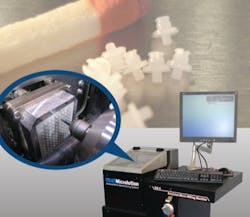System Sizes Up Micromachining Work
Designed by Microlution Inc. (www.microlution-inc.com), the 310-S may have a small footprint, but the company says it packs the spindle speed, acceleration and accuracy necessary for micromachining. Spindle speeds range from 80,000 rpm to 200,000 rpm, and the machine accelerates at a 5-G maximum, positions to within 1 micron and delivers a resolution of 0.02 micron.
According to Andy Philip, president of Microlution, shops micromachining tiny plastic prototype parts, for example, are especially interested in the 310-S because it allows them to directly fabricate such parts instead of having to purchase a mold for producing only a few test parts. He says that intricate prototype molds can cost upwards of $40,000, and waiting for them adds to a job's leadtime.
At a base price of under $90,000, the 310-S not only eliminates the cost of expensive prototype molds, it frees up the large full-size machines that shops would otherwise use for micromachining. And for handling high-volume lights-out production, the 310-S will soon include automatic tool and pallet changing systems.
The 310-S also sports a special kinematic workpiece and spindlemounting system that lets shops remove either workpieces or the machine's spindle then mount them back onto the machine with submicron accuracy. This capability means that shops can swap out the machine's spindle with a lasermetrology head, for instance, to measure parts in process.
More 310-S micro-milling machine features
- AC linear motors on X, Y and Z stages
- Heidenhain linear optical encoders on X, Y and Z stages
- Precision granite support structures
- High-performance, openarchitecture Delta Tau CNC
